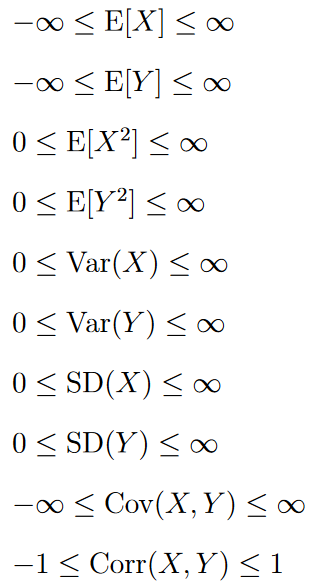Setting
We will once again visualize the act of ordering food at In-n-Out.

Covariance
We define the covariance of random variables as
Correlation
Correlation
Just like how the
- If
- If

- Compute the correlation in the In-n-Out setting
Interpretation of Correlation
Ranges

Aside: the infinity-sized expected values might happen in continuous distributions.
Interpretation of Correlation
Early development of the concept of correlation was done by Karl Pearson. Pearson suggested the following interpretations of the correlation (but there is no strict rule for this):
Examples of Correlation
correlatedValues = function(x, r = 0.9){
r2 = r**2
ve = 1-r2
SD = sqrt(ve)
e = rnorm(length(x), mean=0, sd=SD)
y = r*x + e
return(y)
}
x1 = rnorm(100, mean = 0, sd = 1)
y1 = correlatedValues(x1, r = -0.9)
x2 = rnorm(100, mean = 0, sd = 1)
y2 = correlatedValues(x2, r = -0.4)
x3 = rnorm(100, mean = 0, sd = 1)
y3 = correlatedValues(x3, r = 0.0)
x4 = rnorm(100, mean = 0, sd = 1)
y4 = correlatedValues(x4, r = 0.4)
x5 = rnorm(100, mean = 0, sd = 1)
y5 = correlatedValues(x5, r = 0.9)
df1 <- data.frame(x1, y1, "group 1")
df2 <- data.frame(x2, y2, "group 2")
df3 <- data.frame(x3, y3, "group 3")
df4 <- data.frame(x4, y4, "group 4")
df5 <- data.frame(x5, y5, "group 5")
names(df1) <- c("xdata", "ydata", "group")
names(df2) <- c("xdata", "ydata", "group")
names(df3) <- c("xdata", "ydata", "group")
names(df4) <- c("xdata", "ydata", "group")
names(df5) <- c("xdata", "ydata", "group")
main_df <- rbind(df1, df2, df3, df4, df5)




Continuous Joint Probability Distribution Functions
We will once again visualize the act of ordering food at In-n-Out.
with joint PDF
- Compute the correlation in the In-n-Out setting

Looking Ahead
due Fri., Mar. 17:
- WHW8
- LHW7
Exam 2 will be on Mon., Apr. 10
no lecture on Mar. 24, Apr. 3
